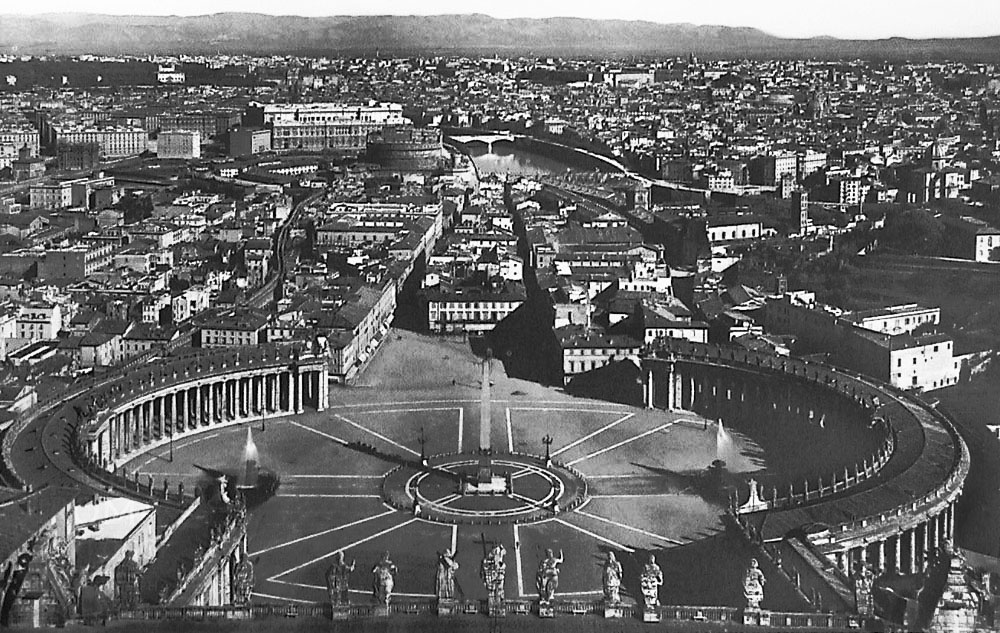|
Getting your Trinity Audio player ready...
|
Above: St. Peter’s square before the Via della Conciliazione was built in 1936.
The Interwar Return of Perosi
In the radiant setting of Easter Sunday in 1934, the Church also rejoiced at the elevation to the altars of John Bosco (†1888) by Pope Pius XI (†1939). Among the elements that made this celebration even more memorable, there was the musical mastery of Lorenzo Perosi (†1956),
who, with his remarkable compositions, restored sacred music to be a sincere and worthy expression of divine worship, freeing it from a certain decadence that had affected it in some cases in the period immediately preceding him.[1]
Perosi returned after an absence of over fifteen years. Starting in 1918, the maestro was afflicted by severe mental disorders that rendered him incapable of directing the Pontifical Choir, a task that was temporarily passed to his brother Marziano. Despite sporadic episodes of physical and mental problems, in 1933, on the occasion of the Holy Year proclaimed by Pope Pius XI, Perosi returned to conduct the Sistine Chapel Choir and resumed composing, creating works such as the Missa Redemptionis and a Te Deum, both for eight voices, in two choirs.
In 1934, Pope Pius XI entrusted Perosi with the task of composing music for the upcoming celebrations in honor of the Piedmontese saint, of whom Perosi was a devoted admirer. In the diary of the Sistine Chapel, on the date of April 1, it reads:
Maestro Perosi, at the Pope’s request, specifically wrote a Mass and a Te Deum for eight voices (in two choirs) which were performed under his own conducting […]. These compositions are modern in style, with many harmonic audacity and, in some points, surprising effect. Written in a few days, it is amazing that a mind considered exhausted like Perosi’s could conceive and treat with all musical logic the two great works.[2]
Particularly noteworthy was the Gloria, hailed as an excellent example of modern harmonization. Another remarkable passage was the Credo, which, following a fugue on the words Et vitam venturi sæculi, concludes with a suggestive and delicate pianissimo.
What prompted Perosi’s resurgence after a prolonged hiatus? An article by lawyer and musicologist Adriano Belli, published in L’Avvenire d’Italia on March 15, 1934, provides valuable information.[3] In it, it is recounted how Perosi, considered by many almost a finished artist, surprised everyone by re-emerging with renewed vitality and energy. It was as if a miracle by Don Bosco himself had awakened him.
Perosi’s motivation lay in his deep devotion to the Holy Father and his desire to be an obedient son of the Church. The Pope had asked him in December 1933 to compose the new works in honor of Don Bosco, and Perosi could only accept with joy and gratitude. “Although desiring to obey, I had to examine and see if I could compose. I could have been… rusty after such a long break!” It was a fast but intense creative process: two months to mature the ideas and five days to put them on paper: “On January 29 (I remember it precisely) in the morning, I took that paper and began to write. On February 2, I called Monsignor Rella, my trusted collaborator, and handed him the Mass. Two days later, I gave him the Te Deum.”
Perosi’s two works were also innovative in their structure: “They are written for two distinct choirs. One is composed of sopranos, altos, tenors, and basses, and the other of first and second tenors, baritones, and basses.” This choice conferred a unique atmosphere on the performances, with an effect of grandeur and solemnity that struck the audience.
And how did he decide to direct?
Another wish of the Holy Father, to which, naturally, I blindly obey. Imagine that the other day H.E. Monsignor Caccia Dominioni came here personally to bring me a large gold medal, which the Holy Father had deigned to send me as His satisfaction for the new compositions and to express His desire that I conduct them. And here I am. Before taking over the direction, however, I wanted to hear the two works on the piano. […] I always compose in score without piano. Having to conduct, I wanted to hear what I had written. I realized that some points presented execution difficulties.

Moreover, Perosi’s desire extended beyond composing and conducting; he envisioned the rebirth of the Sistine Chapel Choir, “with its fixed singers, with its own staff, and with its own regulations. Here is my dream of art, which is then my testament. Can it be realized? I hope so strongly and firmly.”
The miracle of Easter 1934 encompassed not only the canonization but also the artistic resurgence of Lorenzo Perosi. His music, steeped in fervor and devotion, continues to resonate through generations, a testament to the enduring power of faith and human creativity.
As we honor the “father and teacher of the young,”[4] we acknowledge the invaluable contribution Perosi made to the world with his music—a vibrant testament to faith and talent. Don Bosco and Perosi, although belonging to different temporal contexts, unite in their call to beauty and spirituality, inspiring all who encounter them on life’s journey.
[1] Paul VI, Homily, September 24, 1972; our translation.
[2] G. Perricone, Lorenzo Perosi. Nel primo centenario della nascita, in La Civiltà Cattolica, Vol. I, Q. 2941, Rome 1973, p. 34; our translation.
[3] In M. Rinaldi, Lorenzo Perosi, Rome 1967, p. 342.
[4] John Paul II, Iuvenum Patris, January 31, 1988.


